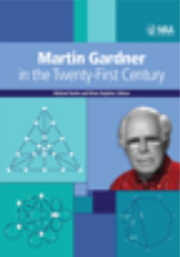Book contents
- Frontmatter
- Preface
- Contents
- I Geometry
- II Number Theory and Graph Theory
- 6 Transcendentals and Early Birds
- 7 Squaring, Cubing, and Cube Rooting
- 8 Carryless Arithmetic Mod 10
- 9 Mad Tea Party Cyclic Partitions
- 10 The Continuing Saga of Snarks
- 11 The Map-Coloring Game
- III Flexagons and Catalan Numbers
- IV Making Things Fit
- V Further Puzzles and Games
- VI Cards and Probability
- VII Other Aspects of Martin Gardner
- Index
- About the Editors
9 - Mad Tea Party Cyclic Partitions
from II - Number Theory and Graph Theory
- Frontmatter
- Preface
- Contents
- I Geometry
- II Number Theory and Graph Theory
- 6 Transcendentals and Early Birds
- 7 Squaring, Cubing, and Cube Rooting
- 8 Carryless Arithmetic Mod 10
- 9 Mad Tea Party Cyclic Partitions
- 10 The Continuing Saga of Snarks
- 11 The Map-Coloring Game
- III Flexagons and Catalan Numbers
- IV Making Things Fit
- V Further Puzzles and Games
- VI Cards and Probability
- VII Other Aspects of Martin Gardner
- Index
- About the Editors
Summary
Alice, the March Hare, the Hatter, and the Dormouse, were standing by the Mad Tea Party (MTP) ride (see opposite page). “We'll start with the same number of teacups as people,” said the Hatter, bossy as usual. “The teacups are arranged in a circle, and each person sits in his or her own teacup.”
“Won't that be lonely?” objected Alice.
“Don't worry,” replied the Hatter, “At the end of this ride, everyone stands up, one of the teacups is removed, then everyone finds a new place to sit. Every teacup has to be occupied by at least one person, so on the second ride there will be one teacup with two people in it. After that ride, another cup will disappear and eventually, when there is just one teacup, no one will be lonely.”
The rest said in unison, “You must be mad. Everyone will be squished and it will be quite unbearable.”
“Not my problem,” the Hatter said, and walked away.
“Wait,” said Alice, who was a keen amateur mathematician, “If there are n people, how many ways are there to fit them into k cups arranged in a circle, assuming, naturally, all people are alike?”
She quickly wrote out the possibilities for n = 5 and k ≤ 5 in Table 9.1, where the actual partitions are in the second row and the number of partitions are in the third row (consistent with the results in [7]).
- Type
- Chapter
- Information
- Martin Gardner in the Twenty-First Century , pp. 53 - 64Publisher: Mathematical Association of AmericaPrint publication year: 2012



